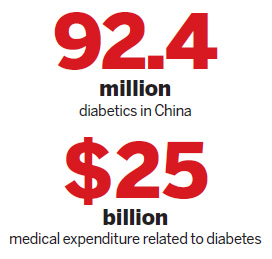Health
At the sharp end of diabetes care
Updated: 2011-08-17 07:54
By Shan Juan (China Daily)
|
A doctor instructs diabetics on the correct way to take insulin injections at a hospital in Xiangfan, Hubei province. Provided to China Daily |
 |
Insulin injection treatment for diabetes sufferers would be much more effective if medical workers and patients did it properly. Shan Juan reports.
Wang Bao'an, 62, has been living with type 2 diabetes for nearly 16 years and injects insulin four times a day to help deal with weak eyesight, itching skin and kidney problems. "I would have been better off if I had started insulin injection therapy earlier," Wang, who is from Shaanxi province, says.
The overweight man has been taking insulin injections for nearly six years, 10 years after he was diagnosed with the chronic disease.
Currently, the nation has an estimated 92.4 million diabetics, about 60 percent of whom have not even been diagnosed, a nationwide epidemiology study conducted by the Chinese Diabetes Society (CDS) shows.
About 35 percent of those who need insulin injection therapy reject the regime, citing reasons like fearing dependence on insulin injections and having trouble ensuring regular injections, according to the study.
"This seriously affects the efficacy of diabetes treatment and the life quality of sufferers," says Ji Linong, head of the CDS, at a diabetes care and management seminar held in Nanjing, Jiangsu province, on Saturday and Sunday, adding that the annual medical expenditure related to diabetes is approximately $25 billion, making up about 13 percent of the total on the Chinese mainland.
"I was recommended by my doctor to start insulin injections after I had been living with the condition for seven years, but I simply ignored (the advice). I found the injections too troublesome, particularly on business trips," Wang says.
In most Western countries, diabetics start taking insulin injections about five to six years after diagnosis, according to the International Diabetes Federation (IDF).
Without timely insulin injection treatment blood glucose levels are difficult to control and there is a greater risk of developing serious complications like kidney problems, a stroke, or even limb amputation.
The only way to reduce or avert these conditions is to control blood glucose levels, says Guo Xiaohui, deputy director of CDS. However, of all the diabetics on the mainland, less than 27 percent have their blood glucose under control, official statistics shows.
Even among those who are taking insulin injections, just 37 percent have well-controlled blood glucose levels, Ji says, citing results from previous studies.
"Poor insulin injections by the patients and medical workers, particularly at the grassroots level, is one of the major factors for this," he explains.
Wang too had problems injecting himself with insulin. Using an insulin pen, widely used worldwide, Wang kept reusing it until it was bent.
"I thought it was OK as the needle was for my use and other patients did it too," he says.
In fact, this caused fat hypertrophy at the injection sites, affecting the accurate intake of insulin.
A regional survey polling nearly 500 patients at 200 diabetes care centers in 10 Chinese cities has found insulin injection problems, such as reuse of the needle, improper injecting skills, and choosing an inappropriate injection site.
Just 22 percent knew the right time and site for injection and how to properly rotate the sites, according to a survey conduced by CDS from September 2008 to June 2009.
About 40 percent of patients forgot to do their insulin injections from time to time and most of the insulin injectors reused the needle largely for economic reasons, the survey showed.
Only 10 percent of the injectors used new needles for each injection, as recommended by health professionals.
Improper use caused pain and bleeding at the injection site, insulin leakage at the injection site, clogging of the devices, and skin problems at injection sites.
Guo emphasizes that correct insulin injection techniques and skills are vital for effective diabetes treatment, even among medical workers at the community level.
"How can they instruct patients properly about insulin injection skills if they themselves are ignorant," Ji, head of CDS, says.
To help address these problems, the relevant health authorities and CDS have initiated a series of awareness campaigns like organizing training for medical workers.
With support from international pharmaceutical companies, Lilly and BD, CDS has just issued the nation's first diabetes drug injection technique guidelines.
"The guidelines mainly target medical workers and we are now working on a second one tailored to patients themselves, in simpler terms and with more illustrations," Ji says.
The full version of the guidelines will be available soon on the Chinese Medical Association website (http://www.cma.org.cn/) for free download.

Specials

Star journalist leaves legacy
Li Xing, China Daily's assistant editor-in-chief and veteran columnist, died of a cerebral hemorrhage on Aug 7 in Washington DC, US.

Robots seen as employer-friendly
Robots are not new to industrial manufacturing. They have been in use since the 1960s.

Smurfs up in China
The movie remake of a classic 1980s cartoon series is expected to have special cross-generation appeal to Chinese filmgoers
